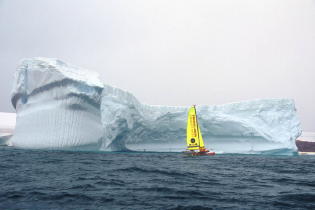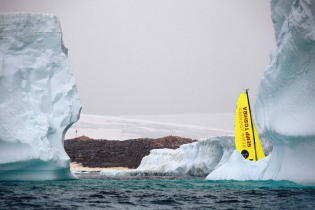The Drake Passage Conquered
by Duncan Ross
On the 7th of February 2003 after an 82-hour sailing marathon Brazilian Roberto Pandiani and South African Duncan Ross became the first sailors to cross the Drake's Passage aboard an open 21-foot catamaran called ‘Satellite’. The Drake’s Passage, infamous for its shipwrecks, huge quadrangular waves, unpredictable storms, icebergs and freezing temperatures, presented a formidable challenge to the two sailors. Stretching from Cape Horn to the Antarctic Peninsula, it represents 500 miles of the most respected and feared waters in the world.
Meticulous planning and precise project management ensured a safe and successful crossing. The vessel choice was a custom built catamaran based on the Hobie 21 hull shape; construction and engineering of which was carried out by Barracuda Technologies, Rio de Janeiro. Kevlar and Carbon fibres surrounding a 12mm Divinycell PVC Foam core were infused with epoxy, producing a bulletproof platform. Further modifications included - foam filled “crash boxes” and a total of five watertight compartments in each hull. A powerful rig including a 24 square meter spinnaker and a 9.6-meter tall mast complemented the 3-meter beam to produce a fast and stable vessel. Two narrow ultra light wings constructed in Carbon further increased the beam and provided a place to rest and store essential safety equipment which included personal EPIRBS, Satellite phones, a Rescue Pod and a Inmarsat C Satellite tracking system.
 |
|
The expedition started in the most southern city of South America, Ushuaia, Argentina. The first leg sailed westwards down the Beagle Canal and across Nassau Bay to reach a small cove called “Calheta Martial,” only a few miles from Cape Horn. From there, choosing what Roberto called “a perfect weather window," the duo set off for Deception Island 500 miles away. The Drake Passage served up a mixture of conditions ranging from dead calm to 25 knots with seas running at up to 5 meters. Seasickness, freezing air and water temperatures left the sailors exhausted to the point of experiencing mild hallucinations as the reached they Peninsula in the early hours of the morning on the 8th February. Elated but exhausted, Duncan commented "it was like scooting across the upturned belly of an sleeping monster – the weather was excellent, we are very happy - it could have been so much worse!"
On the next leg to the Melchior Archipelago 120 miles away, the monster awoke and left the duo on the limit of survival. The weather forecasted 4 to 8 knots, but by the end of the day they were down to 3 reefs in the mainsail in 37 knots of wind. Rolling white water on the tops of a long-range swell coming in from the west met a wind generated swell from the NE to produce an unenviable sea condition. A near collision with a whale, snow, mist and the constant threat of floating ice made this day one to be remembered.
 | |
 |
|
Duncan’s Logbook entry on 13 February entitled ”Eyes Wide Shut” sums it up, “I could never have imagined, guessed or dreamed about the sheer splendor of this place. It is a labyrinth of Islands, bergs and glaciers. My body aches and my hands are numb but my heart is filled with emotion. We have arrived in the frozen continent on a small catamaran – now we are in Antarctica.”
After reaching the Melchior Archipelago ‘Satellite’ and her support vessel 'Kotic' explored the Gerlaiche Strait and surrounding region before returning to Ushuaia. Total round trip time for the expedition was 42 days.
|
 |
|
by Duncan Ross |
|


